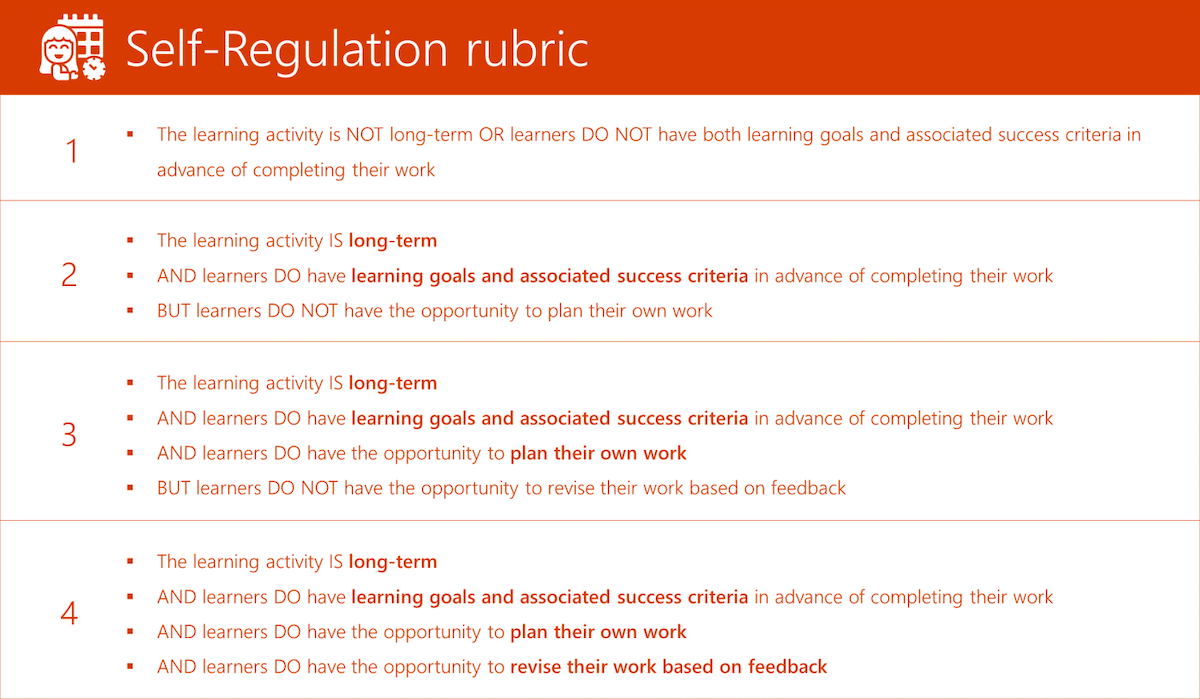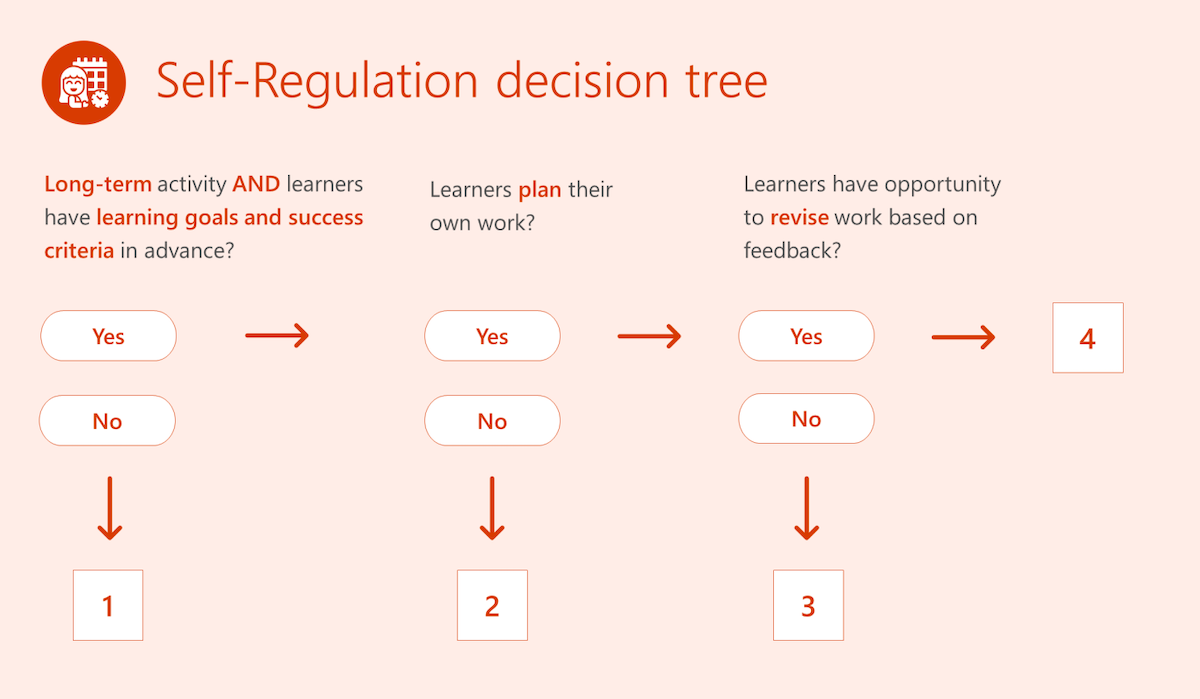Design learning experiences with the self-regulation rubric
The 21st century learning design (21CLD) self-regulation rubric examines whether a learning activity requires learners to self-regulate and to what degree. In stronger activities, learners plan and assess their work. The strongest activities also require learners to revise their work based on feedback.
The self-regulation rubric captures the big ideas of the dimension and is a useful framework for educators when designing learning activities. The varied levels of self-regulation (one to four) in the rubric are:

Go to Rubric – Self-Regulation for an accessible version of the rubric.
The self-regulation decision tree poses three questions that correspond to the rubric. Educators must consider these questions when designing learning activities to deepen self-regulation:
- Is the learning activity long-term and do learners have the learning goals and success criteria in advance?
- Do learners plan and assess their own work?
- Do learners have the opportunity to revise their work based on feedback?

Go to Decision Tree - Self-Regulation for an accessible version of the decision tree.
Is the learning activity long-term and do learners have the learning goals and success criteria in advance?
Length of time is a basic prerequisite for self-regulation. For the purposes of the rubric, a learning activity is long-term if learners work on it for a substantive period. An activity spanning five or more days is long-term. If learners complete the activity within a single class period, they don't have time to plan the process of their work nor to improve their work over multiple drafts.
The following scenario isn't long-term:
- Learners documenting what they ate on two different days
The following scenario is long-term:
- Learners keeping a journal about their nutrition over the course of a week
Learning goals define:
- What children will learn in an activity
- How these goals fit with prior and future learning
Success criteria are the factors used to determine whether learners meet the learning goals. They provide evidence of learners' progress and success in the activity. An understanding of these factors early in the learning activity is another important prerequisite for self-regulation. The educator may provide the learning goals and the associated success criteria. Or, to foster more learner ownership, the class may discuss the learning goals and success criteria together. When learners know the learning goals and associated success criteria in advance, they may examine the progress and quality of their own work as they do it.
Do learners plan and assess their own work?
When learners plan their own work, they make decisions about the schedule and the steps they will follow to accomplish the task. Planning their own work may involve:
- Deciding how to break down a complex task into smaller sub-tasks
- Choosing the tools they will use
- Creating a schedule for their work and setting interim deadlines
- Deciding how learners will divide work among themselves
- Deciding what pieces of the work they will be do in or outside of class
If a task is long-term but educators don’t give learners detailed instructions and timelines, learners don’t have the opportunity to plan their own work. Additionally, learners making decisions about small aspects of tasks doesn't qualify as planning their own work.
In the following scenario, learners don't plan their own work:
- Over two weeks, learners work in groups to research and debate climate change with their peers. The educator assigns specific roles to each learner. Learners follow the steps and timeline provided by the educator.
In the following scenario, learners do plan their own work:
- Over two weeks, learners work in groups to research and debate climate change with their peers. They decide who will research which aspects of the topic and who will speak at different points in the debate. Learners also make their own deadlines for completing their research, writing their speeches, and practicing them.
Do learners have the opportunity to revise their work based on feedback?
Feedback is one of the most significant influences on improving learning. Effective feedback helps learners to address the gap between current performance and performance goals. It’s more than simple praise. Comments such as "good job" or "great work" do little to help learners understand what constitutes great work. Effective feedback tells learners specifically what they are doing well and offers specific guidance to help move their learning forward. It’s directly connected to the learning goals and success criteria. It helps learners be more aware of progress along a learning path and leads to reflection and planning of next steps.
Feedback may come from the educator or from peers. Learners might also have the opportunity to revise their work based on their own deliberate process of self-reflection.
In the following scenarios, learners do not revise their work based on feedback:
- Learners studying environmental conservation creating games in Microsoft MakeCode Arcade where players make decisions to preserve the environment, posting the first version of their games for classmates to play without opportunities to receive or implement feedback
- Learners creating PowerPoint presentations about a topic in world history, giving their final presentation without any opportunity for practice, feedback, or revision
- Learners writing persuasive essays that the educator will assess according to a rubric shared with them at the beginning of the learning activity, then using the rubric only after getting their essays back to see why the educator gave them a certain grade
In the following scenarios, learners revise their work based on feedback:
- Learners studying environmental conservation and create games in Microsoft MakeCode Arcade where players make decisions to preserve the environment. After developing a beta version of their game, learners trade games with a partner and give each other feedback to improve their games before submitting them.
- Learners create PowerPoint presentations about a topic in world history. They practice their presentations, receive feedback from their educator and peers, and revise their presentations based on feedback before giving their final presentation.
- Learners write persuasive essays that the educator will assess according to a rubric shared with them at the beginning of the learning activity. They use the rubric to reflect on their own essay drafts and make revisions.
Now, practice coding one of the anchor lessons in the 21CLD OneNote notebook by doing the following:
- Review the Please Please the Bees learning activity page.
- Consult either the self-regulation rubric or decision tree and code the lesson
- If working with colleagues during this module, discuss your findings
- Refer to the video to compare your analysis with Becky's explanation in the following video:
Bonus: To better prepare for the Microsoft Certified Educator Exam, practice coding more anchor lessons. Suggested activities in the anchor lesson section:
- Great Train Internet
- Design a Catapult
- Falklands War
When you finish coding the lesson, review the coding results summary in the anchor lesson section to compare your findings to others.